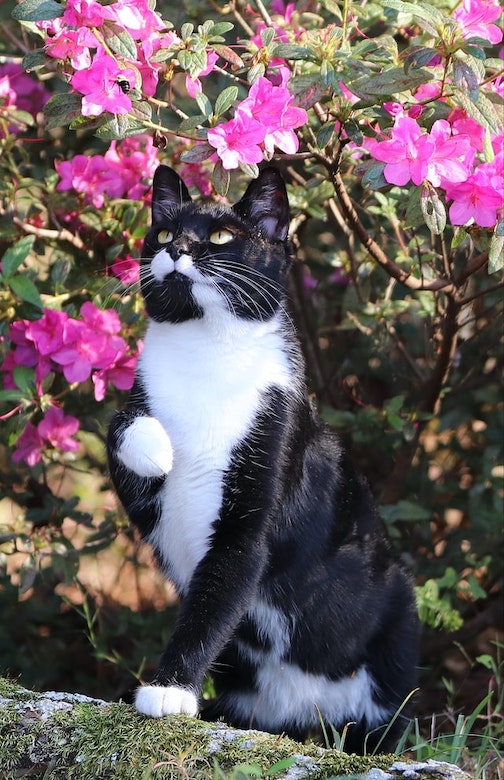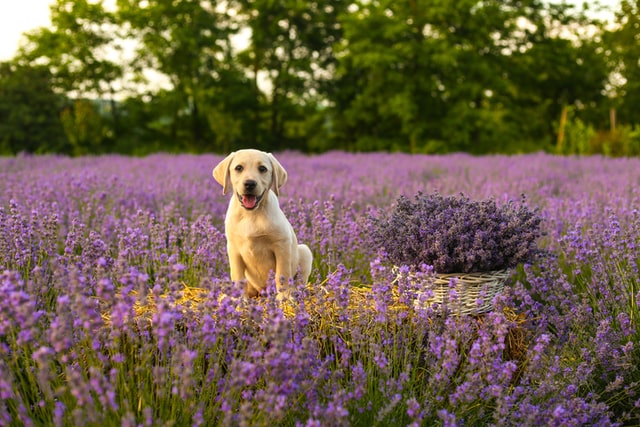There’s still plenty of summer to enjoy this year, but while you are outside with your family and furkids, be aware of the hazards lurking in the tomato plants and the flowering gladiolas. Many outdoor plants are toxic and harmful to dogs and cats. The best way to keep your dog or cat safe is to know what’s in your garden and what plants may be growing outside around your home. Sometimes we know what we’ve planted in our garden, and sometimes we don’t know what’s creeping or growing amongst the roses and shrubs. Here’s a list of outdoor plant hazards for pets, so you can learn how to keep your furkids safe.

Amaryllis
Amaryllis is a spring-producing bulb, but it grows and blooms year round in warm climates. Unfortunately, its bulbs, stems, and leaves are poisonous to pets and fatal to cats. The toxin within the amaryllis is lycorine, an alkaloid chemical. A dog or cat who eats a small amount of this plant will experience gastrointestinal pains, vomiting, diarrhea, and excessive drooling.
However, if your cat eats a significant part of an amaryllis plant, immediately take her to the veterinarian. The amaryllis’ toxin causes a rapid drop in blood pressure, and without treatment, the cat could die. While there isn’t a cure for amaryllis toxin, your veterinarian can assist in helping your cat expel the plant and give her intravenous fluids to keep her safe.
Daffodils
The bright yellow color of the daffodil is always a welcome sign of spring and early summer. As a hardy plant, the daffodil is frequently planted in people’s gardens; but it, too, can be dangerous to your pets. The daffodil is related to the amaryllis, so it shares the same crystalline lycorine chemical that is toxic to pets, especially cats.
A dog or cat who eats a daffodil or the stem and bulb from this plant can become sick quickly. Here are some of the symptoms of crystalline lycorine poisoning in pets:
- Shivering or shaking
- Stomach pain
- Vomiting
- Excessive drooling
- Rapid heart rate
- Heart arrhythmia
- Seizures
- Decreased blood pressure
- Difficulty breathing
Cats are particularly susceptible to this toxin, so if you think your cat has eaten part of a daffodil, take her to the veterinary emergency clinic. The faster your pet is treated, the better the likelihood that she will survive.

Gladiola
Always a favorite, the gladiola is a perennial that adds spikes of pink to gardens everywhere. Sadly, it is a plant that contains toxins, especially within its bulbs. The toxin itself is unknown, but its impact on dogs and cats is all too familiar to pet parents and veterinarians. That impact depends on how much of the plant your pet has ingested.
Pets who eat part of a gladiola can expect to experience vomiting, drooling, diarrhea, lethargy, and excessive salivation. Consumption of this plant on a large scale may result in liver inflammation, kidney problems, cardiac arrhythmias, and death.
Japanese yew
The Japanese yew is one of the most toxic plants, not only to dogs and cats but wildlife as well. This yew contains two toxins, taxine A and B, which quickly affect an animal that has eaten from it. Typical symptoms include difficulty breathing, tremors, and vomiting.
Unfortunately, the Japanese yew’s toxins directly affect a pet’s heart, and if a large enough quantity of yew has been eaten, the pet will die of a heart attack. Most Japanese yew poisonings are not diagnosed until post-mortem. These toxins can kill within minutes to several days after the plant is eaten; thus, prevention is key to avoiding this awful situation.
It’s easy to spot a Japanese yew. They are evergreens with flat needles that grow on both sides of the stem. The needles are darker green on top than below. The yew’s bark is typically reddish-brown and scaly. This yew is often used in landscaping because it is an eye-catching flowering shrub. Check your property for a Japanese yew, and make sure your pets can’t get anywhere near it.
English ivy
The English ivy is a hardy plant that stays green year round, making it a popular ground cover plant in northern climates. This ivy is often used around the winter holidays in wreaths and ornaments. It also spreads quickly, and you may see examples of it spreading up tree trunks or the sides of houses. The English ivy is an invasive species, and it’s difficult to remove it entirely once it spreads.
If that isn’t enough trouble caused by one plant, the English Ivy is also poisonous to pets. It contains polyacetylene compounds and sapogenin, a naturally occurring steroid. These toxins are most concentrated in the ivy’s leaves, although the entire plant is still poisonous. Pets who ingest English ivy will have gastrointestinal distress, diarrhea, and vomiting, and the ivy’s sap can cause a contact rash if it touches the skin. If you suspect your dog or cat has eaten English ivy, contact your veterinarian right away.

Milkweed
Milkweed is best known for its attractiveness to Monarch butterfly larvae, but it is also known for its toxicity to people and pets. The toxin in question is cardenolides, which interfere with the electrolytes in the cardiovascular system. Initial symptoms in a dog or cat who has eaten milkweed include nausea, vomiting, diarrhea, and excessive drooling.
The real danger behind milkweed is if a significant amount has been ingested and effective veterinary treatment has not begun. In large amounts, milkweed eventually causes nervous and cardiovascular problems, seizures, tremors, and, in some severe cases, death.
Tomato plants
While we certainly advocate for homegrown vegetables, the tomato plant is one you need to keep your pets away from. Tomato plants have glycoalkaloids alpha-tomatine and dehydrotomatine, which are found in the green parts of the plant, such as the stem and leaves. The toxins are strongest when the tomato plants are unripened and still green. Ripe tomatoes may cause minor upset if your pet eats them, and cooked tomatoes are perfectly appropriate for your pet to eat.
A pet who eats the stem or leaves of an unripened tomato plant may exhibit changes in her behavior, gastrointestinal distress, vomiting, drooling, diarrhea, and lethargy. If you suspect your cat or dog has eaten part of the tomato plant, call your veterinarian for advice on the next steps to take.
Pet insurance is there for you and your furkid.
As pet parents, we adore the furry members of our family; we also know that they can (and probably will) eat something they shouldn’t at some point in their lives. Be ready for any emergency with a pet insurance policy. Get a free quote for pet insurance, and they’ll have your back and paws when trouble happens.
References:
- SF Gate Contributor. (2021). Is Amaryllis Poisonous to Cats? Retrieved from https://homeguides.sfgate.com/amaryllis-poisonous-cats-71428.html
- Vets Now. (2020). Vets issue poison warning after cat nearly dies from eating daffodil. Retrieved from https://www.vets-now.com/2020/03/cats-and-daffodils-dangers/
- ASPCA. (2021). Gladiola. Retrieved from https://www.aspca.org/pet-care/animal-poison-control/toxic-and-non-toxic-plants/gladiola
- Rocky Mountain Elk Foundation. (2017). Over 78 Elk, Antelope and Bear Dead: Japanese Yew and How You Can Identify It. Retrieved from https://www.rmef.org/elk-network/japanese-yew-plant-responsible-killing-wildlife-can-identify/
- Wag Walking. (2021). Japanese Yew Poisoning in Dogs. Retrieved from https://wagwalking.com/condition/japanese-yew-poisoning
- Cope, R.B. (2005). Toxicology Brief: The dangers of yew ingestion. Retrieved from https://www.dvm360.com/view/toxicology-brief-dangers-yew-ingestion
- Ecosystem Gardener. (2021). English Ivy: Most Hated Plants. Retrieved from http://www.ecosystemgardening.com/english-ivy-most-hated-plants.html
- Cozzens, B. (n.d.). Is Milkweed Poisonous to Dogs? Retrieved from https://dogcare.dailypuppy.com/milkweed-poisonous-dogs-8075.html
- Paretts, S. (n.d.). Are Tomato Leaves Dangerous for Cats & Dogs? Retrieved from (https://pets.thenest.com/tomato-leaves-dangerous-cats-dogs-5664.html
Disclaimer
The information contained on this blog is intended for informational and educational purposes only and should not be construed as medical advice. It is not a substitute for professional veterinary care. Always consult with your veterinarian before making any changes to your pet's health care or treatment plan.
The authors of this blog are not veterinarians and do not claim to be experts in pet health. The information provided here is based on our own experiences and research, as well as information from reputable sources. However, we cannot guarantee the accuracy or completeness of this information.
We encourage you to do your own research and consult with your veterinarian before making any decisions about your pet's health.
Previous post
Hazardous Indoor Plants and Your PetNext post
Dog Meds 101: Trazodone for DogsCompare top pet insurance providers & plans.
Enter your dog’s age in years and months to calculate their age equivalent to human years.
Calculate your dog’s ageEnter your cat’s age in years and months to calculate their age equivalent to human years.
Calculate your cat’s age